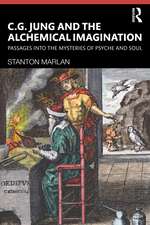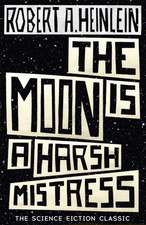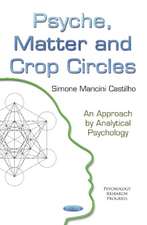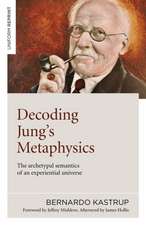Four Archetypes: Routledge Classics
Autor C. G. Jungen Limba Engleză Paperback – 9 ian 2003
Din seria Routledge Classics
- 5%
 Preț: 132.94 lei
Preț: 132.94 lei -
 Preț: 101.17 lei
Preț: 101.17 lei - 5%
 Preț: 89.26 lei
Preț: 89.26 lei -
 Preț: 153.70 lei
Preț: 153.70 lei -
 Preț: 113.15 lei
Preț: 113.15 lei -
 Preț: 145.75 lei
Preț: 145.75 lei -
 Preț: 125.23 lei
Preț: 125.23 lei -
 Preț: 108.21 lei
Preț: 108.21 lei - 5%
 Preț: 88.43 lei
Preț: 88.43 lei -
 Preț: 124.19 lei
Preț: 124.19 lei -
 Preț: 109.78 lei
Preț: 109.78 lei -
 Preț: 123.85 lei
Preț: 123.85 lei -
 Preț: 121.89 lei
Preț: 121.89 lei -
 Preț: 93.84 lei
Preț: 93.84 lei -
 Preț: 109.24 lei
Preț: 109.24 lei -
 Preț: 86.93 lei
Preț: 86.93 lei -
 Preț: 95.54 lei
Preț: 95.54 lei -
 Preț: 92.66 lei
Preț: 92.66 lei -
 Preț: 123.03 lei
Preț: 123.03 lei -
 Preț: 146.51 lei
Preț: 146.51 lei -
 Preț: 94.66 lei
Preț: 94.66 lei -
 Preț: 110.69 lei
Preț: 110.69 lei -
 Preț: 92.77 lei
Preț: 92.77 lei -
 Preț: 110.32 lei
Preț: 110.32 lei -
 Preț: 64.19 lei
Preț: 64.19 lei -
 Preț: 122.91 lei
Preț: 122.91 lei -
 Preț: 123.12 lei
Preț: 123.12 lei -
 Preț: 111.10 lei
Preț: 111.10 lei -
 Preț: 86.43 lei
Preț: 86.43 lei -
 Preț: 144.59 lei
Preț: 144.59 lei -
 Preț: 123.35 lei
Preț: 123.35 lei -
 Preț: 121.87 lei
Preț: 121.87 lei -
 Preț: 109.98 lei
Preț: 109.98 lei - 20%
 Preț: 70.14 lei
Preț: 70.14 lei -
 Preț: 93.49 lei
Preț: 93.49 lei -
 Preț: 123.12 lei
Preț: 123.12 lei -
 Preț: 125.12 lei
Preț: 125.12 lei -
 Preț: 124.13 lei
Preț: 124.13 lei -
 Preț: 136.69 lei
Preț: 136.69 lei -
 Preț: 108.18 lei
Preț: 108.18 lei -
 Preț: 122.91 lei
Preț: 122.91 lei -
 Preț: 108.06 lei
Preț: 108.06 lei -
 Preț: 136.51 lei
Preț: 136.51 lei -
 Preț: 109.31 lei
Preț: 109.31 lei -
 Preț: 93.89 lei
Preț: 93.89 lei -
 Preț: 122.91 lei
Preț: 122.91 lei -
 Preț: 123.89 lei
Preț: 123.89 lei -
 Preț: 139.32 lei
Preț: 139.32 lei -
 Preț: 94.82 lei
Preț: 94.82 lei
Preț: 122.50 lei
Nou
23.44€ • 24.47$ • 19.40£
Carte disponibilă
Livrare economică 14-28 martie
Livrare express 27 februarie-05 martie pentru 18.97 lei
Specificații
ISBN-10: 0415304415
Pagini: 216
Ilustrații: black & white illustrations
Dimensiuni: 129 x 198 x 12 mm
Greutate: 0.22 kg
Ediția:Revizuită
Editura: Taylor & Francis
Colecția Routledge
Seria Routledge Classics
Locul publicării:Oxford, United Kingdom
Public țintă
General, Postgraduate, and Undergraduate CoreNotă biografică
Carl Gustav Jung (1875-1961). Founded the analytical school of psychology and developed a radical new theory of the unconscious. Carl Gustav Jung (1875
Recenzii
'His idea of the archetype involves profound attitudes towards man's existence and intimate values through which very many people have found a new significance in their lives.' - R.F. Hobson, Journal of Analytical Psychology
Cuprins
Descriere
The concept of the archetype is crucial to Jung's radical interpretation of the human mind. Jung believed that every person partakes of a universal or collective unconscious that persists through generations. The origins of the concept can be traced to his very first publication in 1902 and it remained central to his thought throughout his life. As well as explaining the theoretical background behind the idea, in Four Archetypes Jung describes the four archetypes that he considers fundamental to the psychological make-up of every individual: mother, rebirth, spirit and trickster. Exploring their role in myth, fairytale and scripture, Jung engages the reader in discoveries that challenge and enlighten the ways we perceive ourselves and others.




























